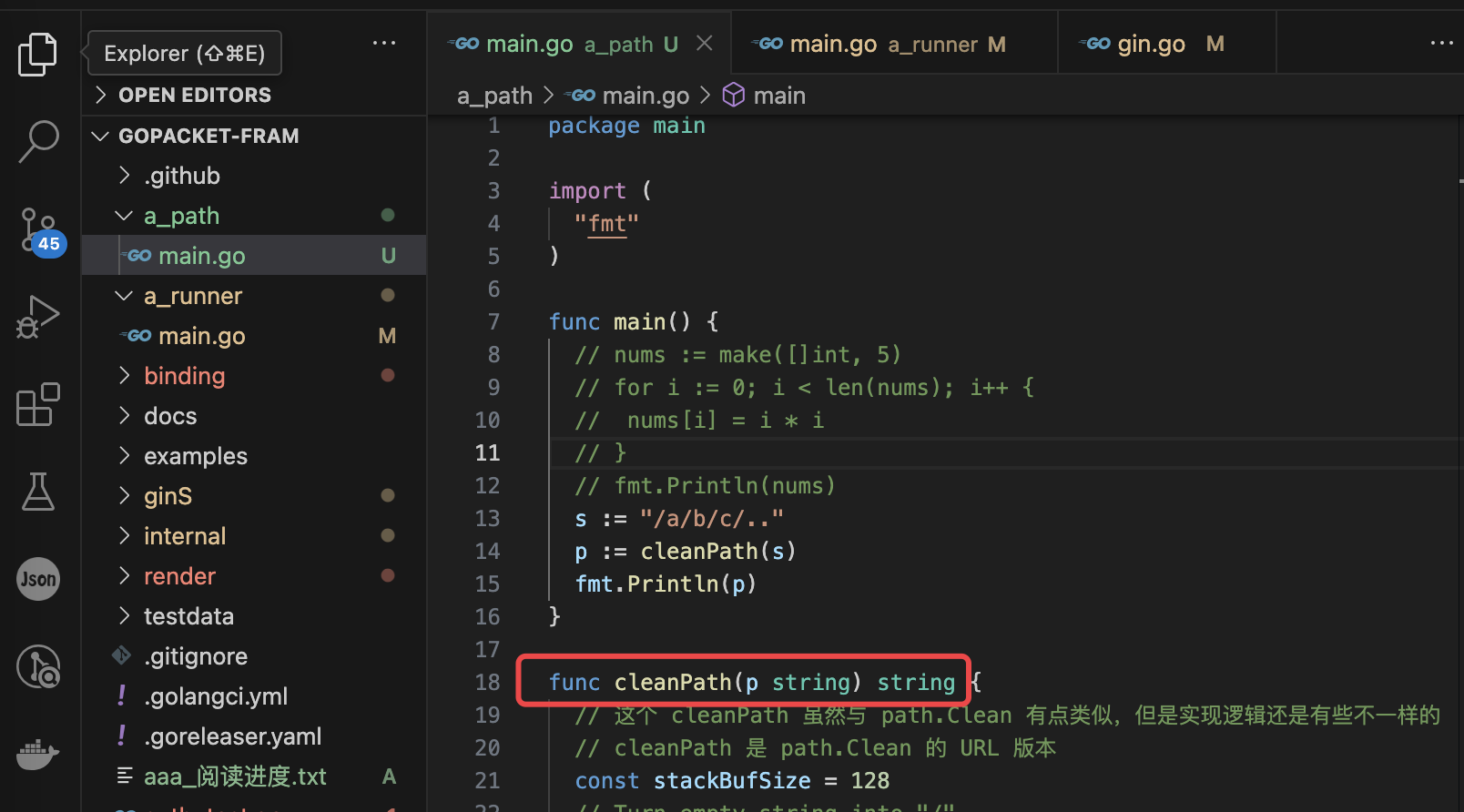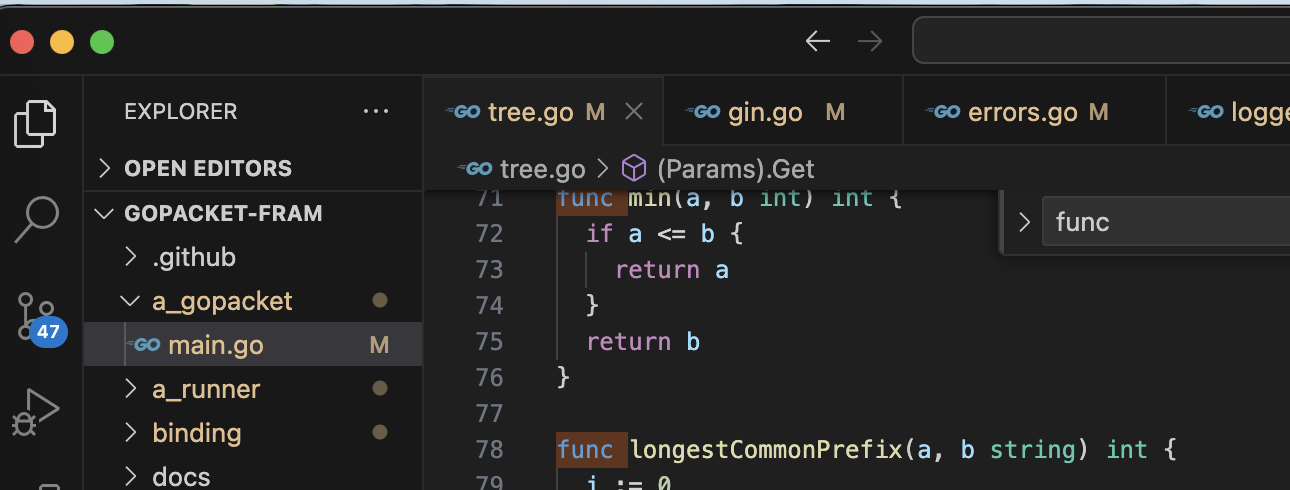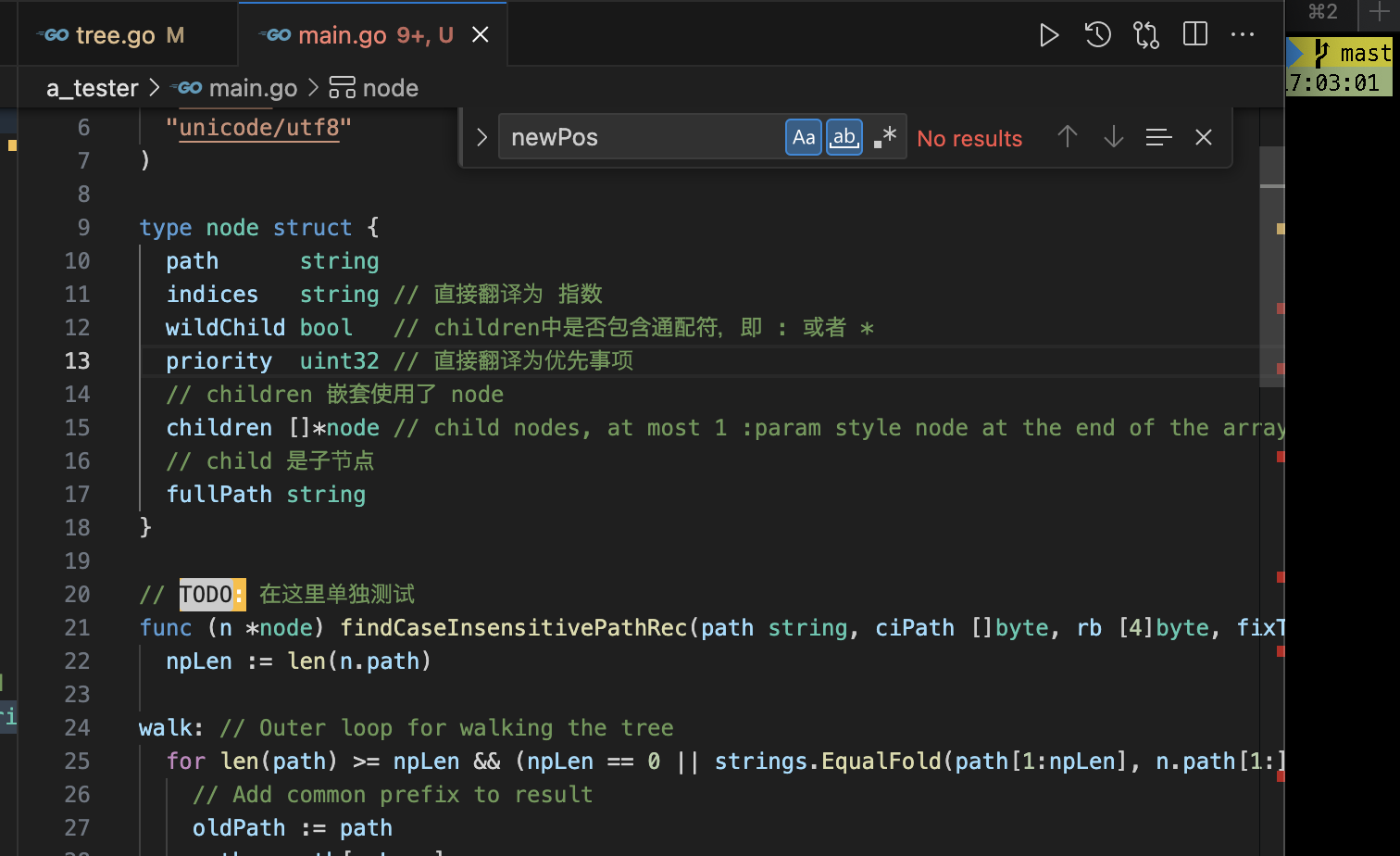我把代码复制到了 ~/我的本地文件/代码/fromweb 目录下了。目前clone了gin项目和go-gin-example项目,此外还有example项目,这个是gin官方提供的示例项目。
##go-gin-example阅读
读取配置和数据库初始化的过程,可以放在func init() 里,参考:
1 2 3 4 5 6 7 func init ()
init已经看完了,下面就是看 routers.InitRouter() 的具体内容
准备看 r.POST(“/auth”, api.GetAuth) 及之后的内容了。
项目里使用到了https://github.com/beego/beego框架,用了其validation包做数据验证,其他的包没有使用。
beego框架可以用于开发包括传统的 Web 网站、API 服务、后台管理系统
validation包的使用方法可以参考:
1 2 3 4 5 6 type auth struct {string `valid:"Required; MaxSize(50)"` string `valid:"Required; MaxSize(50)"`
用到了https://github.com/unknwon/com包,这个是针对 Go 编程语言常用函数的开源项目。
router目录存放了rest api的路由定义和rest api的rest部分,而且router的目录结构和路由的结构也是一样的
1 2 3 4 5 6 7 8 .
已经读完了,笔记都记录在了项目里,没有记录在这个文档里面
gin源代码阅读 我电脑上gin的储存位置为 ~/MyLocalFile/代码/fromweb/gopacket-fram,改名是为了上班时看便于伪装,这个项目里记录了我阅读时的笔记记录。
gin是一个知名的HTTP web框架。
对于gin的调用处一般都是这样写的:
1 2 3 4 5 6 7 8 9 10 11 12 13 14 15 16 17 18 19 func main () ":%d" , setting.ServerSetting.HttpPort)1 << 20 "[info] start http server listening %s" , endPoint)
1 2 3 4 5 6 7 8 9 10 11 12 13 func InitRouter () "/api/v1" )"/tags" , v1.GetTags)"/articles/poster/generate" , v1.GenerateArticlePoster)return r
gin项目没有main.go文件,其实:
可以理解为通常的入口文件。
返回的Engine实现了http的ServeHTTP方法
1 2 3 type Handler interface {
gin官方提供了一个example项目,https://github.com/gin-gonic/examples,里面列举了一些gin的用法
go:build 是一个编译指令(build constraint),用于在不同的Go版本或操作系统之间条件编译代码。!go1.20表示如果Go版本小于1.20,那么以下代码块将会被编译,否则将被忽略。go1.20 表示如果Go版本等于1.20或更高,那么以下代码块将会被编译,否则将被忽略。
golang有个类型是any,是原生的,其作用和interface相同,其实是interface的别名
1.16更新
看关于cleanPath的实现
进度记录 1.18准备看这个tree.go文件
还是在看tree相关的
gin的路由功能使用了“前缀树“的数据结构
参考
前缀树的插入操作是添加一个新的字符串到 Trie 树中并尝试最小化数据存储 (即对某些节点进行合并)。
因为基数树的本质依然属于字典树,因此在查找使用上和字典树并无不同。从根节点开始遍历字符串,对于每个字符,检查当前节点的子节点是否包含该字符,如果包含,则继续遍历下一个字符,否则说明该字符串不存在于 Radix 树中。
Radix 树的查找操作相对于 Trie 树的查找操作有一个优点,因为基数树通过压缩,使得在前缀有一定规律的串在树中的深度更低,因此查找效率也较高。
因为 Engine 就实现了 ServeHTTP,这里会将 Engine 本身传给 ListenAndServe 方法,当监听的端口有新的连接时,ListenAndServe 会负责 accept 建立连接,并且在连接上有数据时,会调用 handler 的 ServeHTTP 方法进行处理。
阅读源代码可以参考网上的文章 ,围绕gin的这几个特点来阅读:
Middleware support
Crash-free
JSON validation
Routes grouping
Error management
Rendering built-in/Extendable
1.31 在看
runtime.Caller a_tester下的func stack(skip int) []byte
关于runtime.Caller函数:
用于获取调用栈的信息,包括调用者的文件名、行号和函数名。函数定义为:
1 func Caller(skip int) (pc uintptr, file string, line int, ok bool)
pc 表示调用者函数的程序计数器(program counter),用于标识调用者函数的指令地址。file 表示调用者函数所在的文件名。line 表示调用者函数所在的行号。ok 表示是否成功获取了调用者的信息,如果成功为 true,否则为 false。当传递的i值太大了,没有对应的调用者信息,返回的ok就是false。
传递0表示调用Caller函数的位置的信息,传递1表示调用Caller函数的位置所在函数 的调用者的信息,比如:
1 2 3 4 5 6 7 8 func main () 0 )func stackTest (i int ) ".........." , pc, file, line, ok)
传递0打印出来的结果是:
1 .......... 17359146 /Users/rhettnina/MyLocalFile/代码/fromweb/gopacket-fram/a_tester/main.go 15 true
也就是调用runtime.Caller这一行的代码信息,包括所在文件,行号等等
传递1打印出来的结果是:
1 .......... 17359069 /Users/rhettnina/MyLocalFile/代码/fromweb/gopacket-fram/a_tester/main.go 11 true
因为调用runtime.Caller的函数是stackTest,也就是runtime.Caller的一级调用者是stackTest,传递0返回的是1级调用者的调用详情。传递1表示的是一级调用者的调用者 也就是二级调用者的调用信息,二级调用者main函数是在main.go的第11行调用的。
router匹配 主要就是看tree.go这个文件
24.2.22 正在研究ginrouter的匹配方法
gin的路径匹配部分使用的是基数树(Radix Trie)数据结构,这是一种多叉树,是一种更节省空间的Trie(前缀树)。也就是努力将多个节点合并为一个。基数树中作为唯一子结点的每个结点都与其父结点合并,每个内部结点的子结点数最多为基数树的基数 r,r 为正整数且等于2^n(n>=1)。参考文章
要解决的问题:
gin.PrintNode打印出来的indices字段是什么意思,这个字段的euqsa、/、euq、pu、ts这些值是什么意思
wildChild字段是干什么的
indices作用 indices是所有子child的path的第一个字母连起来的字符串,比如:
1 2 3 4 5 6 7 8 9 10 11 12 13 14 15 16 17 18 19 20 21 22 23 24 25 26 27 28 29 30 31 32 33 34 35 36 37 38 39 40 41 42 43 44 45 46 47 48 49 50 51 52 53 54 55 56 57 58 59 60 61 62 63 64 65 66 67 68 69 70 71 72 73 74 75 76 77 78 ...............printNode.... HEAD
这里第一个indices的值是euq,然后它有三个child,三个child的path分别为export、upload/images、qrcode,其实euq就是这三个path的首字母拼起来的。
作用:目前看起来是寻找路径对应的handler时会根据indices的每个字符进行匹配,验证该路径的hander是否存在于当前节点。但是这个字段好像是和wildChild一起使用的???
wildChild wildChild似乎是表示children中是否包含通配符,即 : 或者 *
1 2 3 4 5 6 7 8 9 10 11 12 13 14 15 16 17 18 19 20 21 22 23 24 25 26 27 28 29 30 31 32 ...............printNode.... GET
priority? 好像不是child的数量
handler handler中记录了所有的中间件和处理函数,
1 2 3 4 5 6 7 8 func InitRouter () "/export" , http.Dir("xxxx" ))
export对应的handler是最后一个,里面有三个元素,分别对应了gin.Logger()、(gin.Recovery()和http.Dir(“xxxx”),注意这个handler的父各个节点的handlers都是空
1 2 3 4 5 6 7 8 9 10 11 12 13 14 15 16 17 18 19 20 21 22 23 24 25 26 27 28 29 30 31 32 ...............printNode.... GET
24.2.23更新:
1 2 3 4 5 func (n *node) string , handlers HandlersChain)
addRoute这个的实现是最关键的
这是是关于如何添加路由
还有需要看的是
1 func (n *node) string , params *Params, skippedNodes *[]skippedNode, unescape bool ) (value nodeValue)
这是是关于如何寻找路由
都是tree.go里的函数,我决定把tree.go里面的函数都看一遍,先看简单的,看懂了就标记下来,看不懂的最难的放到最后。
utf8包的RuneStart函数解析 :
1 func RuneStart (b byte ) bool { return b&0xC0 != 0x80 }
这个函数是用来判断一个字节是否是 UTF-8 编码的字符序列的起始字节的
0xC0的二进制是1100 0000,0x80的二进制是1000 0000
b&0xC0相当于只取b二进制的前两位,b&0xC0 != 0x80 就是判断b的前两位不是10
这里补充下utf8编码规范:
对于某一个字符的UTF-8编码,如果只有一个字节则其最高二进制位为0。
如果是多字节,其第一个字节从最高位开始,连续的二进制位值为1的个数决定了其编码的位数,其余各字节均以10开头。UTF-8最多可用到6个字节。
根据上面的编码规则可以看出,utf8编码的第一个字节只能为0xxxxxxx、110xxxxx、1110xxxx 、11110xxx 、 111110xx 、1111110x 中的某一个,显然如果是10开头就不满足要求,不可能是utf8编码的第一个字节。所以是10的话就是UTF-8 编码中的非起始字节。
utf8包的DecodeRune函数解析 :
1 func DecodeRune (p []byte ) rune , size int )
接受一个字节切片 p 作为参数,并返回两个值:rune 类型的字符值 r 和 int 类型的字符所占用的字节数 size。
函数的作用是解码字节切片 p 中的 UTF-8 编码字符序列,并返回第一个 Unicode 字符以及其所占用的字节数。如果字节切片 p 不是一个有效的 UTF-8 编码字符序列,函数将返回 rune 类型的 Unicode 替代字符 RuneError(通常是 Unicode 编码中的 U+FFFD)以及 0。
3.7 更新:最近以及之后大概一直在阅读tree.go文件
阅读 findCaseInsensitivePathRec 函数
3.7 更新:
看得差不多了,但是还有 rb 和 off 这两个变量相关的东西没看懂,不知道这俩干啥的,测试也测试不到我想要的路径,已经在gin源代码里添加TODO了。🤡🤡🤡
函数定义为:
1 func (n *node) findCaseInsensitivePathRec(path string, ciPath []byte, rb [4]byte, fixTrailingSlash bool) []byte
fixTrailingSlash的意思是修复尾部斜杠
wildChild是用于标记子节点中是否有通配符的,如果有则wildChild为true
举例示例 findCaseInsensitivePathRec函数fixTrailingSlash的作用 1 2 3 4 5 6 7 8 9 10 11 12 13 14 15 16 17 18 19 20 21 22 23 24 25 26 27 28 29 30 31 32 33 34 35 36 37 38 39 40 41 42 43 44 45 46 47 48 49 50 51 52 53 54 55 56 func main () "/" ,"au" ,false ,"/" ,3 ,nil ,"api/v1/tags" ,"_" ,false ,2 ,"/api/v1/tags" ,func (*Context) func (*Context) func (*Context) func (*Context) "_1" ,"" ,false ,1 ,"/api/v1/tags_1" ,func (*Context) func (*Context) func (*Context) func (*Context) "users/" ,"" ,true ,1 ,"/" ,":id" ,"" ,false ,1 ,"users/:id" ,func (*Context) func (*Context) func (*Context) "/users/user1/" , nil , [4 ]byte {}, false )".....findCaseInsensitivePathRec....." , string (r))
因为传递的findCaseInsensitivePathRec的第三个参数为false,打印出来的r是空的。如果传递的findCaseInsensitivePathRec为true,那么打印出来的findCaseInsensitivePathRec就是 /users/user1/
当两个路径中都有参数时,且参数后都有一个路径,生成的tree是什么样子的 比如对于这两个路由:
1 2 3 4 5 6 7 8 9 10 11 r.GET("/users/:id/ccc" , func (c *gin.Context) "id" )200 , "CCC User ID: %s" , id)"/users/:id/dddd" , func (c *gin.Context) "id" )200 , "DDD User ID: %s" , id)
调用时可以这样传递参数:
1 curl --location 'http://localhost:9934/users/user1/dddd'
返回的结果是:
那么对于路径/users/:id/ccc和/users/:id/dddd,生成的路由tree是什么样子的呢?
我预期的生成结果是类似:
1 2 3 4 users/
但是实际上的结果是:
1 2 3 4 5 users/
打印出来的完整node结果是:
1 2 3 4 5 6 7 8 9 10 11 12 13 14 15 16 17 18 19 20 21 22 23 24 25 26 27 28 29 30 31 32 33 34 35 36 37 38 39 40 41 42 43 44 45 46 47 48 path: /
为什么非要把这两条路径相同的:id/部分拆成两个node呢?分别是:id和/,且/是:id的子节点?
主要是因为findCaseInsensitivePathRec实现的过程中有一些特殊之处。关键在于下面的一段代码:
1 2 3 4 5 6 7 8 9 10 11 12 13 14 15 16 17 18 19 20 21 switch n.nType {case param:0 for end < len (path) && path[end] != '/' {append (ciPath, path[:end]...)if end < len (path) {if len (n.children) > 0 {0 ]len (n.path)continue
这一段,只有节点的nType为param时才能执行到这里。显然path为:id的node执行findCaseInsensitivePathRec会走到这里。因为这里直接在len(n.children) > 0的情况下使用了n.children[0],并且执行了continue操作进入下个循环。所以显然gin默认执行到if len(n.children) > 0 {这里时只有一个children,所以需要在设置tree时让这里只有一个节点,所以设置/为:id的下一个节点而不是设置:id/为一个节点才能满足这里n.children[0]的需求。如果设置:id/为一个节点,那么这个节点必然有两个children,也就是ccc和dddd,那么这里直接取n.children[0]就无法取到第二个path为dddd的节点,就会出现问题了。
路由里的特殊参数 **路由里的:**,用于匹配参数,用法如下:
比如对于这两个路由:
1 2 3 4 5 6 7 8 9 10 11 r.GET("/users/:id/ccc" , func (c *gin.Context) "id" )200 , "CCC User ID: %s" , id)"/users/:id/dddd" , func (c *gin.Context) "id" )200 , "DDD User ID: %s" , id)
调用时可以这样传递参数:
1 curl --location 'http://localhost:9934/users/user1/dddd'
返回的结果是:
路由里的*
符号通常用于匹配任意的路径片段,被称为通配符路由。
使用 * 符号时,这意味着该路由会匹配所有以它之后的路径。这样的路由通常用于处理动态的、不固定的路径。
比如:
1 2 3 4 5 r.GET("/static/*filepath" , func (c *gin.Context) "filepath" )200 , "Static file path: %s" , filepath)
下面调用一下进行测试:
1 curl --location 'http://localhost:9934/static/abc'
运行结果为:
1 curl --location 'http://localhost:9934/static/*filepath'
运行结果为:
1 Static file path: /*filepath
1 curl --location 'http://localhost:9934/static/*filepath'
运行结果为:
1 Static file path: /abc/dddd
1 curl --location 'http://localhost:9934/static/*filepath/xxxx'
运行结果为:
1 Static file path: /*filepath/xxxx
可见/static/*filepath路由中的filepath会把/static之后的所有内容都匹配出来。一直匹配到传入路由的末尾。
我试了下,如果再在*filepath 后面追加东西,显然追加东西的话是多余的、不正确的操作,比如这样写:
1 2 3 4 5 r.GET("/static/*filepath/xxx" , func (c *gin.Context) "filepath" )200 , "Static file path: %s" , filepath)
程序会在启动时直接panic。
阅读 getValue函数 getValue函数的定义是:
1 func (n *node) string , params *Params, skippedNodes *[]skippedNode, unescape bool ) (value nodeValue)
3.13 更新,看得差不多了,但是还有一些细节不太明白,可能要把tree的代码都大概过一遍之后再看第二次
阅读 findWildcard函数 这个很简单,飞快看懂了,小问题!
阅读 insertChild函数 看得大概懂了,但是不是100%
阅读 addRoute函数 函数定义为:
1 func (n *node) string , handlers HandlersChain)
注意:定义相同的路由会直接panic
比如
1 2 3 4 5 6 7 8 9 10 11 r.GET("/notnow/:filepath/*xxxx" , func (c *gin.Context) "filepath" )200 , "Static file path: %s" , name)"/notnow/:filepath/*yyyy" , func (c *gin.Context) "filepath" )200 , "Static file path: %s" , name)
如果这样定义路由,程序会直接Panic,因为/notnow/:filepath/*xxxx和/notnow/:filepath/*yyyy本质上是一条路由。
1 2 3 4 5 6 7 8 9 10 11 r.GET("/notnow/:filepath/*xxxx" , func (c *gin.Context) "filepath" )200 , "Static file path: %s" , name)"/notnow/:filepath/abc/*yyyy" , func (c *gin.Context) "filepath" )200 , "Static file path: %s" , name)
这样的也会报错,因为有些路由匹配时会有歧义,比如/notnow/love/abc/1 既可以匹配第一个,此时xxxx的值是abc/1,也可以匹配到第二个路由,此时yyyy的值是1。
3.18 更新,这个函数也都看完了,但是没有怎么懂。我准备画gin的架构图,根据架构图来画一个系统之类的。


